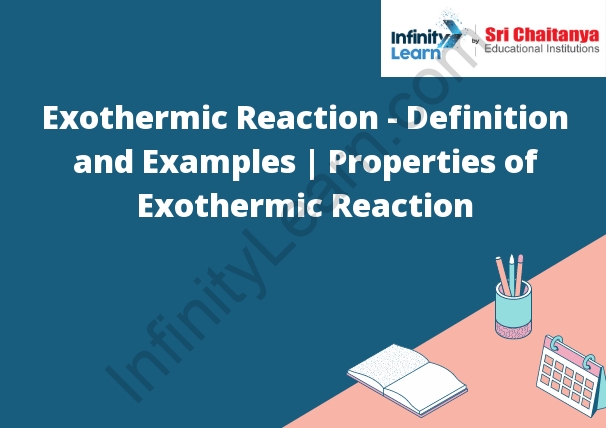Table of Contents
Exothermic Reactions by Infinity Learn
Exothermic Reaction – Exothermic Reactions is the flow of the net transfer of heat energy during the reaction is from the medium into its surroundings. In exothermic reactions, the reactants always possess more energy than the products and hence are less stable. For this reason, the exothermic reactions require very less amount of activation energy to initiate the reaction.
- Exothermic reactions are those in which energy is released in the form of heat. The heat can be used to do work, such as warming a room or cooking food. It can also be used to cause a change in the state of a substance, such as boiling water or melting ice. In an exothermic reaction, the reactants expend energy to form the products. This energy is released in the form of heat, which makes the reaction go faster.

What is an Exothermic Reaction?
An exothermic reaction is one that releases energy in the form of heat. This can be seen in many chemical reactions, such as the combustion of gasoline. In this reaction, the fuel is combined with oxygen from the air to create heat, water vapor, and carbon dioxide.
Enthalpy
- Enthalpy is a thermodynamic quantity that is a measure of the internal energy of a system plus the product of its pressure and volume. The enthalpy is a state function, meaning that its value depends only on the current state of the system and not on the path taken to reach that state. Enthalpy is expressed in units of energy per unit mass, typically joules per kilogram (J/kg).
- The enthalpy of a system is determined by its temperature, pressure, and composition. The enthalpy can be used to calculate the change in energy for a system when it undergoes a process, such as heating or cooling.
Examples of Exothermic Reactions
- An exothermic reaction is a chemical reaction that releases energy in the form of heat. This can be seen when two substances react and the temperature of the reaction mixture rises.
- One example of an exothermic reaction is the reaction between hydrogen and oxygen to form water. In this reaction, the reactants combine to form a product that is at a lower energy state than the reactants. This released energy is in the form of heat, which is why the reaction mixture becomes warm.
- Another example of an exothermic reaction is the combustion of gasoline in a car engine. In this reaction, the gasoline is oxidized to form carbon dioxide and water. The released energy is in the form of heat, which is why the engine gets hot.
Combustion of coal
The combustion of coal is a process that releases heat energy and carbon dioxide into the atmosphere.
Detonation of Nitroglycerin
The detonation of nitroglycerin is a very rapid and violent process. The explosive force is created by the combustion of the nitroglycerin, which is a very fast-burning fuel. The heat from the combustion causes the nitroglycerin to rapidly expand, and the expansion of the gas creates the explosive force.
Nuclear Fission of Uranium-235
The nuclear fission of uranium-235 can be described by the equation:
- 23592U+1n→92Kr+141Ba+3He
- This equation represents the mass and energy balance of the nuclear fission reaction. The mass of the uranium-235 atom is converted into the mass of the three products of the fission reaction. The energy released by the fission reaction is equal to the sum of the masses of the products multiplied by the speed of light squared.
Neutralization Reactions
A neutralization reaction is a chemical reaction that occurs when an acid and a base react to form a salt and water.
- Acid + Base → Salt + Water
Why is Respiration an Exothermic Reaction?
Respiration is an exothermic reaction because it releases energy in the form of heat. This heat is used to power the cell’s metabolic processes.
What is the Importance of Learning the Concept of Exothermic Reactions?
Exothermic reactions are important because they release energy in the form of heat. This energy can be used to do work, such as moving a car, or it can be used to heat something up, such as a house.








